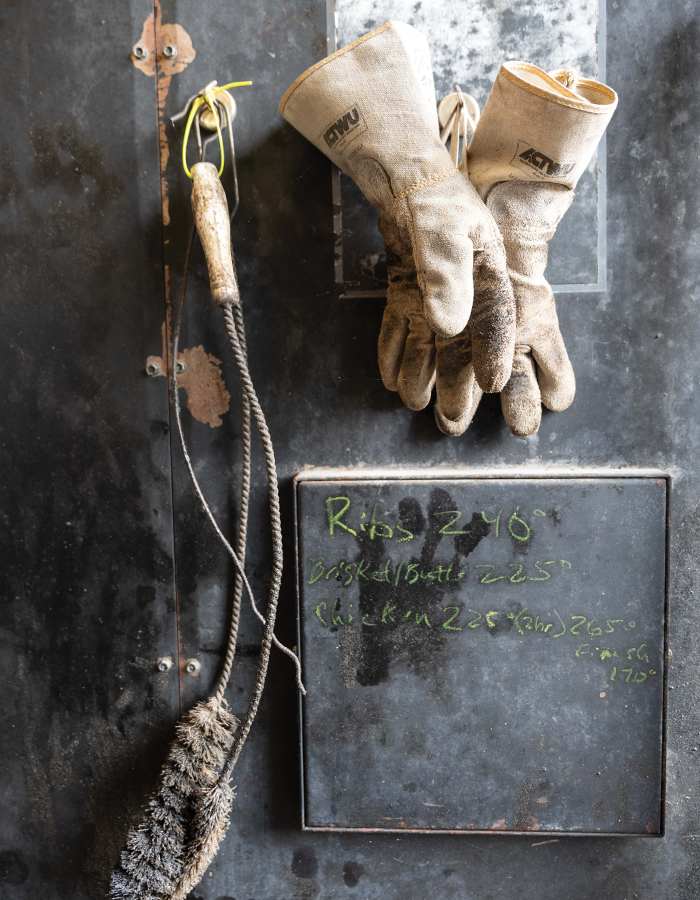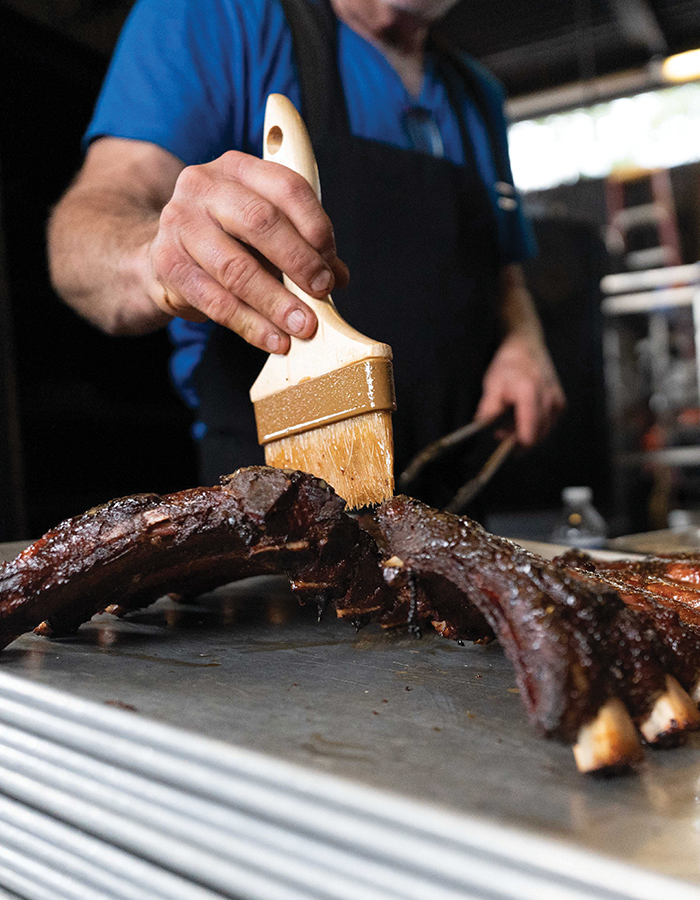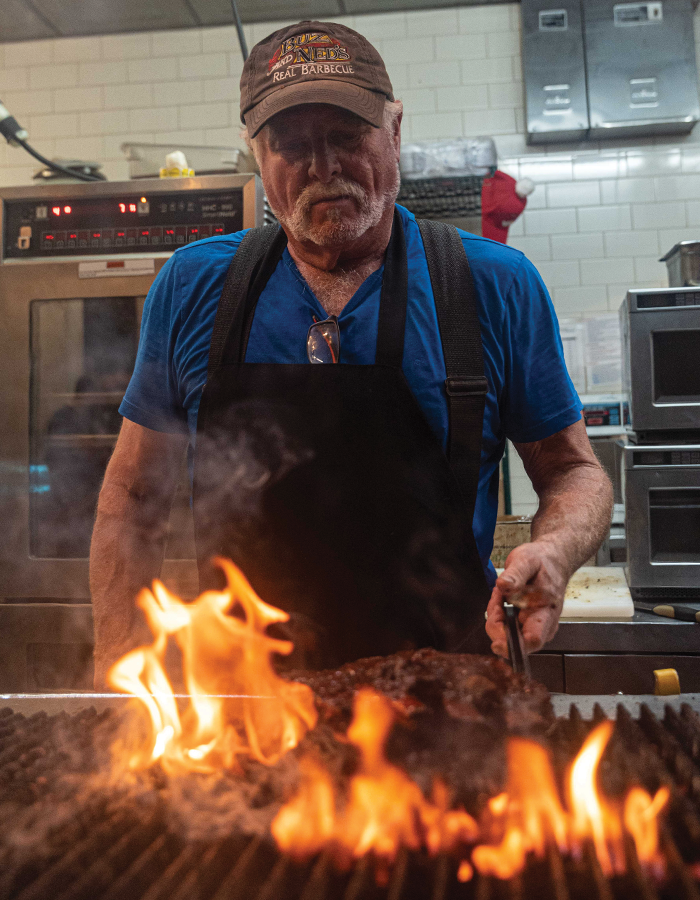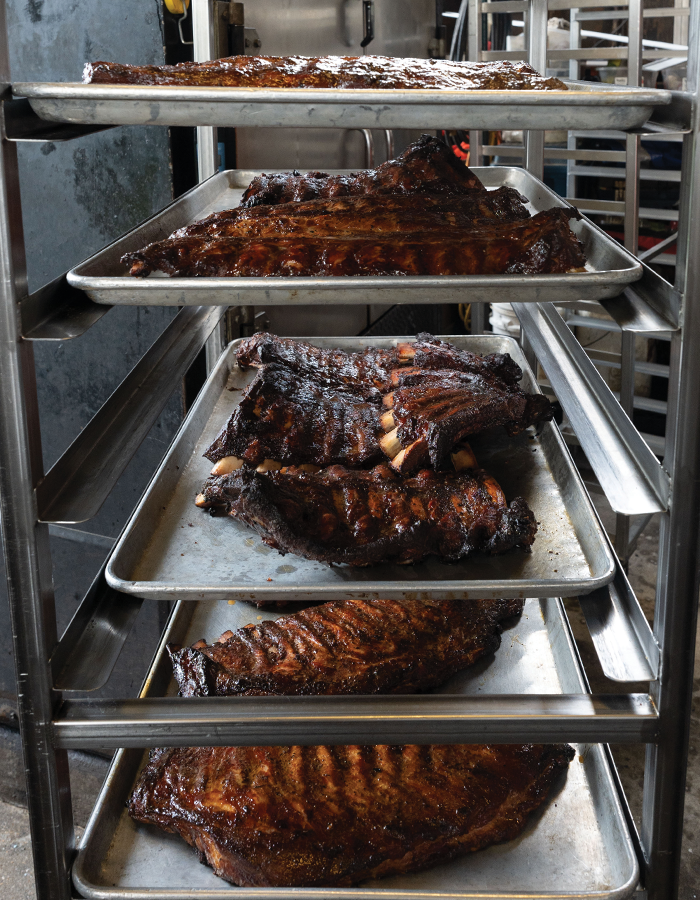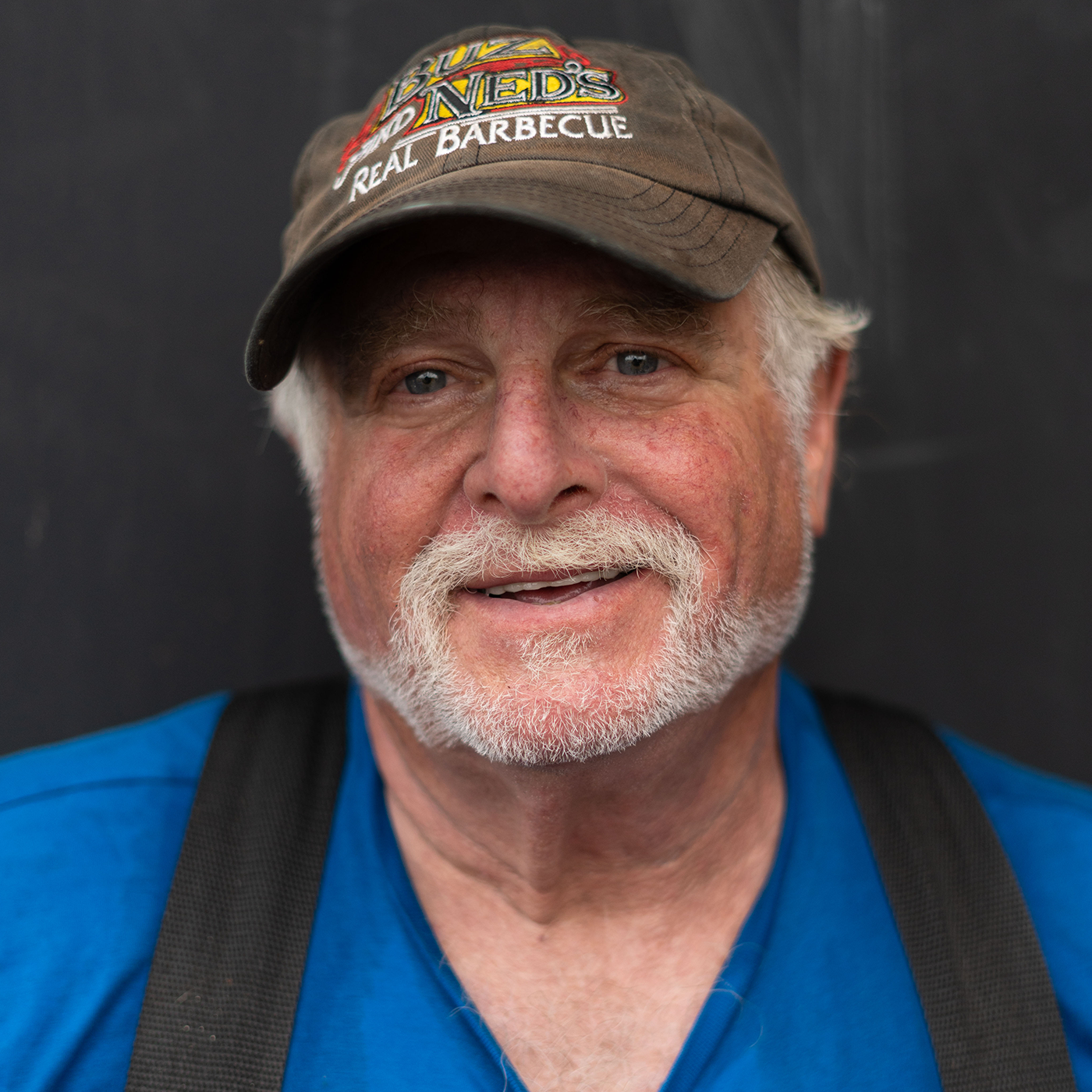
Business & Economics
Primeval Eye
Elemental cooking always fascinated Buz Grossberg (B.S.’77), one-time Food Network star and the proprietor of Richmond’s landmark Buz and Ned’s Real Barbecue. After four decades, the pitmaster is still exploring the bond between man and fire.
Buz Grossberg (B.S.’77) arrives at Buz and Ned’s Real Barbecue in Richmond at a smidgen past 7:30 a.m. And so do I.
Buz (because only his creditors call him “Grossberg”) drives a big white SUV, ideal for transporting U-9 soccer teams or towing small sauropods. After a salutatory honk of his GMC, Buz introduces himself.
He’s wearing suspenders, jeans and a beard cropped like a putting green, and his physique suggests he delivered ice in 1904. He’s a Taurus, 70 years old and, my heavens, are his blue eyes enchanting, although my favorite thing about his face is his nose.
Buz looks at the sky above the southwest corner of West Broad Street and Parham Road, where his restaurant inhabits a zhuzhed-up old Fuddruckers, and announces that it’s hazy. Parts of Canada are on fire today. The air is the color of a “Breaking Bad” episode, which makes sense because Vince Gilligan is from Richmond.
Now, as he does every day but Tuesday (because he’s off), Buz is going to make barbecue. But first, he is going to make fire.
“Have you ever been in the Boy Scouts?” he says.
“No, but I go camping a lot.”
Buz is the founder, proprietor and pitmaster of Buz and Ned’s Real Barbecue, now four decades old and a Richmond hallmark. (Ned, a seemingly mythical figure, is Buz’s late barbecue mentor.) Buz started Buz and Ned’s in 1992 as a cart downtown and outside the Green Top Sporting Goods store off U.S. Route 1. In 1995, he upgraded to a rented shack under a squat billboard on the Boulevard, where word of mouth and frequent media encomiums helped make his hole in the wall a destination.
He opened the Broad Street location in 2012, five years after being a total ham in season two, episode eight, of “Throwdown! with Bobby Flay,” during which two local food writers fancied Buz’s spareribs more than Flay’s. Buz says the episode, which for a long time ran on infinite repeat in his restaurants and on occasional repeat on the Food Network, helped double his business at the time.
Real estate barons forced the Boulevard shack’s shuttering last year, sentencing it, along with the rest of the block, to death-by-razing to make way for luxury apartments in Scott’s Addition. Now Buz and Ned’s, a mainstay of city and regional “Best of” lists (and local hearts), exists only here on West Broad.
“I had to make do with what I had at the old store,” Buz says. “This was more of a planned thing — what I wanted to do if I ever had the opportunity to design my own place. As you can see, it’s a two-edged sword. You lose the total funkiness of a tiny little hole in the wall, but you are also able to do so much more.”
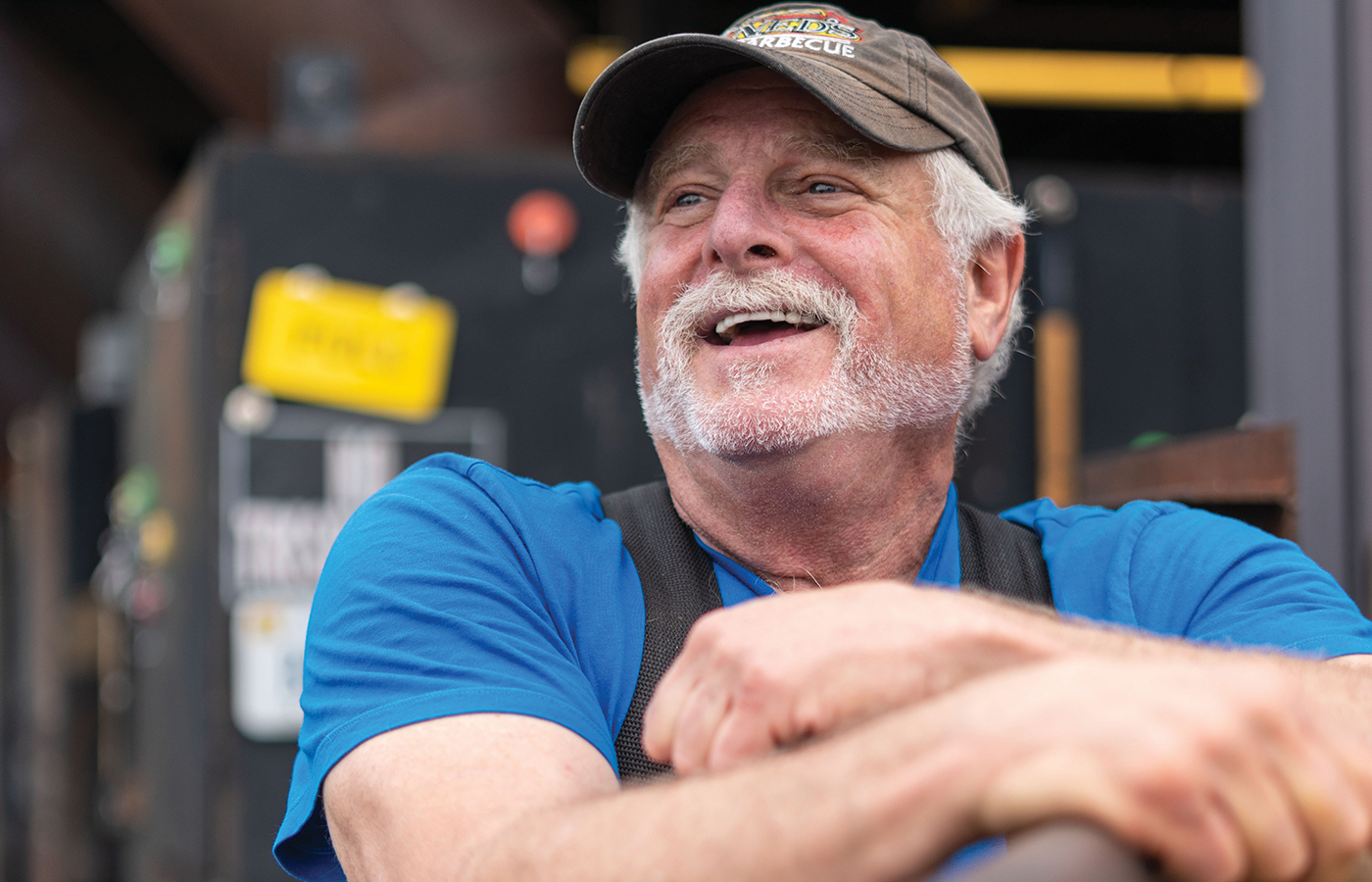
Bruce "Buz" Grossberg opened Buz and Ned's Real Barbecue in Richmond as a food cart in 1992. (Jud Froelich)
Buz and Ned’s 3.0 spent two years in industrial hair and makeup to funk itself up. It’s part resurrected warehouse, part defrocked cathedral, accessorized with secondhand woods and metals and a great big, scary propeller of a ceiling fan, likely off a prewar Decepticon.
The restaurant is dark and quiet now. It doesn’t open for four hours, but even at this uncivil hour, Broad Street sounds like the interstate on a three-day weekend.
Outside, Buz walks to the restaurant’s left, where $90,000 worth of J&R Manufacturing black steel barbecue pits sit in something like a carport. It’s the sort of place the CIA might take people to ask questions. There are sundry tools, jumper cables and two working chain saws.
There’s also a Bluetooth speaker. Buz just signed up for Spotify. I’m sure he likes other singers, but he mentions only Cab Calloway.
Buz loads kindling and two split, moist hickory logs into the firebox of the first of his three pits. They look like evil refrigerators.
“If it wasn’t for finding this machine, I would never have gotten into the barbecue business,” Buz says. “Everything else either was run by gas, which wasn’t going to be my operation, or it requires total attention and tending.”
Buz is invoking the pitmaster archetype, a lone country figure arranging coals and assaying smoke colors overnight at an open pit in a more ancient part of the 20th century. This business model is romantic, transcendental.
Apparently, it’s also expensive.
“That was not tolerable, either,” Buz says, “because that’s an extra person that doesn’t do anything but sit out and tend the pit — which is what I ended up with anyway. Except when I’m doing it, I’m doing a million other things.”
Buz stacks the wood in the firebox to promote and perpetuate oxygen flow. He reiterates that it’s just like making a campfire, except this process has more in common with starting a locomotive.
The first thing Buz does after lighting a propane flamethrower (and the wood, obviously) is make coffee and eat a frozen brownie.
“I had a commissary in Glen Allen in a canning shack behind somebody’s house, and it was beautiful,” Buz says, recollectin’ on Buz and Ned’s origins as the fire gets goin’. “I would get there at 6 in the morning, and the sun’s just starting to come up, and it’s a little bit cooler — it was gorgeous. And I pull the meat off and chop it and put it in pans and put it on the cart and then go downtown for lunch. It was just mesmerizing for me. I love fire for some reason. I’m not a pyromaniac, but I love fire.”
“Did you play with fire as a kid?”
“Yeah.”
“Did you ever burn anything down? Light yourself on fire?”
“No, but I almost did.”
“Go on.”
“I was in the storage area of the apartments that we lived in, in Henrico. I was playing with denatured alcohol, somehow, and didn’t realize that if you spilled it, it continues to burn wherever that denatured alcohol is. So I dropped some on the floor, and it started to burn — and this is all wood-frame cubicles, and it would have gone up like crazy. I finally got it out myself.”
“How old were you?”
“I was in elementary school, maybe. It scared the s— out of me.”
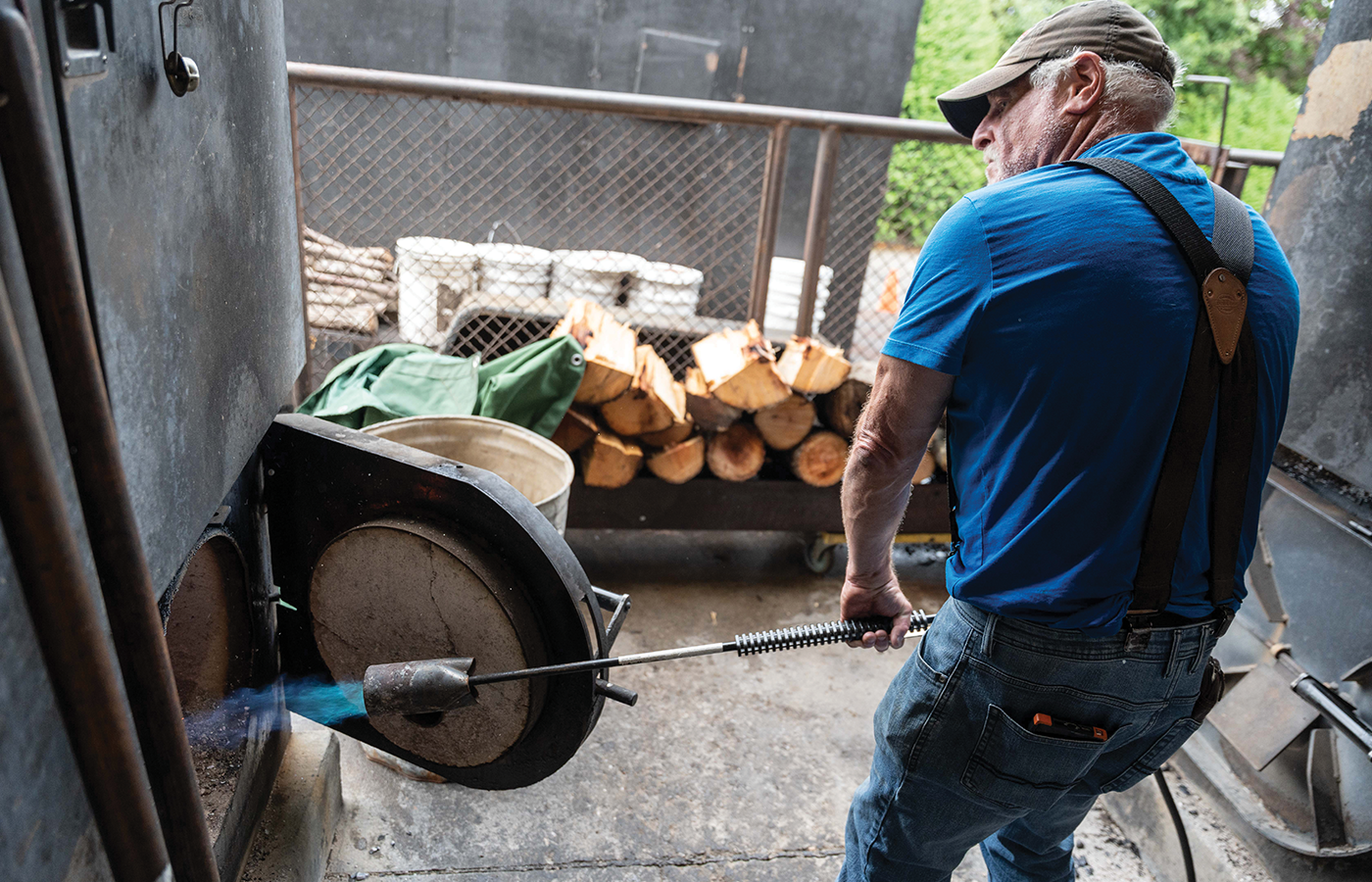
Buz uses a propane torch to start a fire. (Jud Froelich)
Today, a plain June Thursday, Buz is smoking 24 pork shoulders (“butts”), 16 briskets, 24 racks of baby back ribs, 15 racks of spareribs and 10 racks of beef ribs. They are rubbed with salt, black pepper, brown sugar, garlic powder and paprika and then anointed with Buz’s beloved Lea & Perrins.
He heaves the meat, butts first because they take the longest to slow-cook, into the pit and onto racks, which rotate like languid Ferris wheels. The arrangement is precise and avant-garde at the same time. One rogue rack wobble can botch the whole proceeding and foul the 7-amp servomotor, hence all the handyman/interrogation equipment. Replacing a set of racks costs about $1,500.
“You have a big cavity in there,” Buz says, explaining the pit’s insides. They resemble oblivion. “You have a thermocline, I call it. If you’re a diver, you know what a thermocline is.”
I am not a diver.
“The surface is very warm,” he says. “As you go down, it gets colder and colder and colder, in layers. Same thing here. The hottest part is at the top where hot air is ascending. Then you have the middle, which is where I calibrate [the temperature]. At the bottom, if it’s 200, and maybe 300 degrees up top, you try to hit for 225, let’s say, here.” He points to the pit’s center. “That’s the idea of the rotating shelves. They go through all those heat differences, but it’s not exact.”
“That’s one of the reasons I love barbecue,” I say. “Because it’s just a little inexact. There’s a feel to it — you’ve got to feel it. There’s a little magic involved.”
“There’s still a lot of magic! Everybody says, ‘Oh, it’s so easy. It’s automatic.’ No, it’s not. You’ve got to know, first of all, the quality of your wood, and then you’ve got to know the rapidity — or how fast that stuff is burning in the firebox. If it burns too fast, it’s going to release chemicals too fast, and you’re going to get that creosote taste.”
“A what taste?”
“Creosote. Tastes of old telephone pole or railroad ties.”
Buz fumbles a non-Apple smartphone from his jeans, which fit handsomely. Then he fumbles with the touchscreen until he finds his stored photographs, stopping at one of a rack of spareribs. He presents the screen for consideration.
“That,” I say, “is a gorgeous color. That’s the other thing about barbecue being art: When it’s done right, the colors are so pretty. That sheen. The dark red —”
“That’s when you nail it,” Buz says.
“How many pictures of barbecue do you think you have on your phone?
“Not that many.”
“These were just particularly handsome ribs, and you thought you might want to document them for posterity?”
“That — and maybe to use on social media.” Buz is shopping for a social media person. And a lieutenant pitmaster. And a general manager. The pandemic was hard. “One of my friends said it looks like an angel’s wing. It’s,” he says, pausing, “heavenly.”
Buz fumbles the phone back into his jeans, opens the firebox hatch, which may or may not be repurposed from a torpedo tube, and checks his logs.
“The two together have a symbiotic relationship,” he says. “They keep each other burning. You have two logs trapping heat with the convection air going between them to boost the fire.”
“Did you learn that in the Boy Scouts?”
Buz admits he got kicked out of the Boy Scouts.
“Blue is the purest, mildest smoke that can come from a log,” he says. “White is the next level. If you have anything less than white, any kind of tinge to that white, you’ll start smelling a harshness to the smoke, and it’ll change the color of the product that you’re cooking. So you don’t want that. And if something happens accidentally — like you put a log in that’s not burning properly because of, I don’t know, it might be rotten inside — you need to check that and pull it out of there if it’s giving off bad smoke and replace it with a different piece of wood. But you should know your wood enough to know what you can put in here and what shouldn’t go in there.”
“What does a piece of good wood look like?”
“As white as it can be. But usually if the wood is burning well and it smells good, it’ll stay that way.”
Buz keeps as little as possible between man, fire and meat. His rubs are simple, as is his sauce. He doesn’t bother with gadgets like injectors — “Baloney!” he decries, dismissing those discomfiting turkey baster-looking syringes — or with the foil-wrapping of briskets and pork shoulders during a smoke, a method called (maybe snootily) the “Texas crutch.” It’s supposed to help (maybe lesser) barbecuists keep their bark unburnt.
J Frank, formerly of the Berkeley Hotel in downtown Richmond and now of The Disgruntled Chef, a restaurant/market 80-some miles north of New York City, is one of Buz’s longtime chef friends. He used to serve Buz and Ned’s pulled pork sandwiches at the Berkeley because he was “so enamored” with Buz’s barbecue.
“More is not always better,” Frank says. “You can lose yourself, or your idea of what you’re actually trying to acquire and achieve, with the ‘more.’ I visited some of those places in North Carolina” — he means the old-timey-type places like Lexington BBQ or the Skylight Inn that helped define/mythologize the pitmaster archetype — “and when I ate it, I was like, ‘What am I missing?’ And I realized that these guys are just going real basic. They were the original barbecue. It was salt and pepper, maybe some crushed red pepper, some cayenne or something. Not a lot of ingredients. It was smoking meat. [Buz] learned from some of the pros early on — whoever he picked up his ideas from and studied or researched — that, back in the day, the concept was: Let the product speak for itself. The correct smoke is huge if done right.”
Barbecue is an abusive medium. It’s toting and chopping wood, tending fires, moving slick, weighty meats and fixing machinery. It can take all day or all night, or both, and in all seasons. The infinite vagaries make consistency feel like a holy quest. Somewhere, pitmastering and ordination probably intersect.
“If somebody’s not working with you long enough to inherit the passion that you have, then they’re just cooking. That’s not what barbecue is,” says friend-o-Buz Jimmy Sneed, who was responsible for the nationally esteemed The Frog and the Redneck, which served Shockoe Bottom from 1993 to 2001. “There are some dishes — there are some foods that you can only cook if you’ve got the touch, if you’ve got the passion, and you can’t explain it. I can make a dish just like I ate somewhere else, and it’s just not right. It’s not the ingredients.”
Twice nominated for a James Beard Award, Sneed worked under Jean-Louis Palladin at the Watergate and cooked with Julia Child on PBS. He met Buz at the cart one day while shopping for ammunition at Green Top and today is retired by the James River in between trips to Paris.
“Buz has an abundance of passion,” says Sneed, who has since converted to pescatarianism. “And honestly, when he was cooking back in the day, it was the best barbecue possible.”
Bruce “Buz” Grossberg’s family moved to Richmond from Manhattan’s Lower East Side when he was in the third grade. His father, Ned (not that Ned), a World War II Army medic, also started calling his energetic, combustion-curious son “Buz” after the German V-1 cruise missile, which the Allies referred to as a “buzz bomb.” (The single Z spelling comes from Buz’s insistence that “buzz” is a sound and “Buz” is a name.)
Buz, a culinary autodidact, got into food through his mom, Essie, an “intuitive cook” who never made anything the same way twice. At VCU while studying sociology, Buz hosted Friday-night comfort food dinners in his Franklin Street apartment. Dishes such as pot roast and spaghetti and meatballs main-evented.
In the early 1980s, he moved with his then-wife to Sonoma County, California, where her family had a ranch with a Santa Maria grill. The lovely weather makes cooking outdoors popular in Northern California, and Buz, embracing the lifestyle, got into grilling and smoking. He also tried to become a cowboy, but it turned out like the Boy Scouts.
Eventually, Buz started moving among the wine people of Northern California, learning the event and restaurant business and studying food.
“He has probably one of the best palates I’ve ever seen,” says Johnny Giavos, the restaurateur behind Stella’s, The Sidewalk Cafe and Little Nickel, who came up with Buz in the Richmond restaurant scene. They like to drink bourbon together. “That’s how he figures out his flavors.”
After his marriage ended in the mid-’80s, Buz returned to Richmond, working odd jobs for years. Still, he kept secret dreams of owning a restaurant. In 1992, inspired by the success of a local cart and seeing a hole in Richmond’s barbecue market, Buz rented his Glen Allen commissary and started making fire.
“It was a fascination with that whole process of primeval cooking — cook like the cavemen cook,” Buz says. “Instead of a gas-fired oven, an electric this, it was all kind of back to a basic, fundamental type of cooking. It’s how the human species started after they stopped eating everything raw, I guess.”
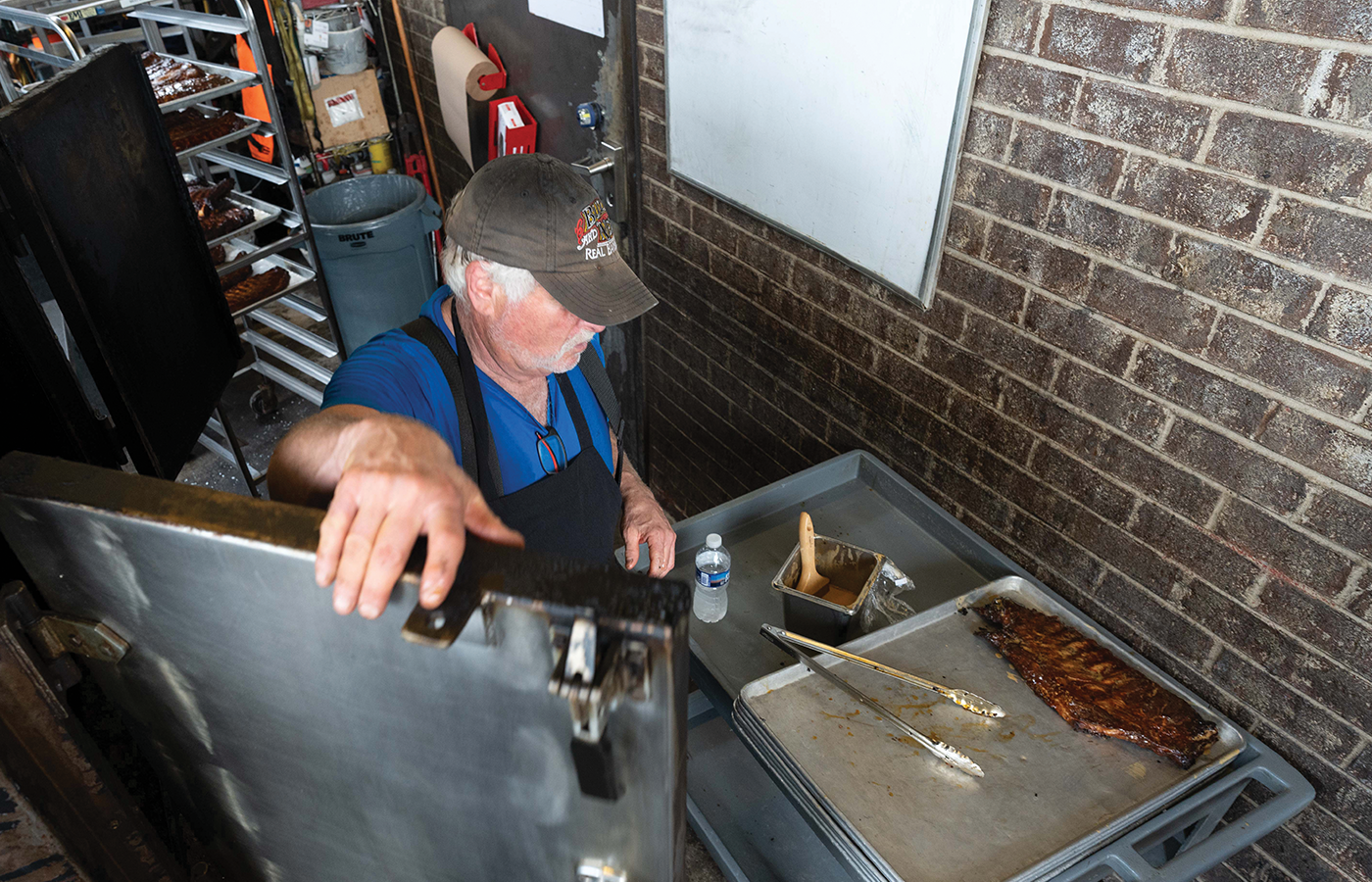
Buz pulls baby back ribs from the smoker. (Jud Froelich)
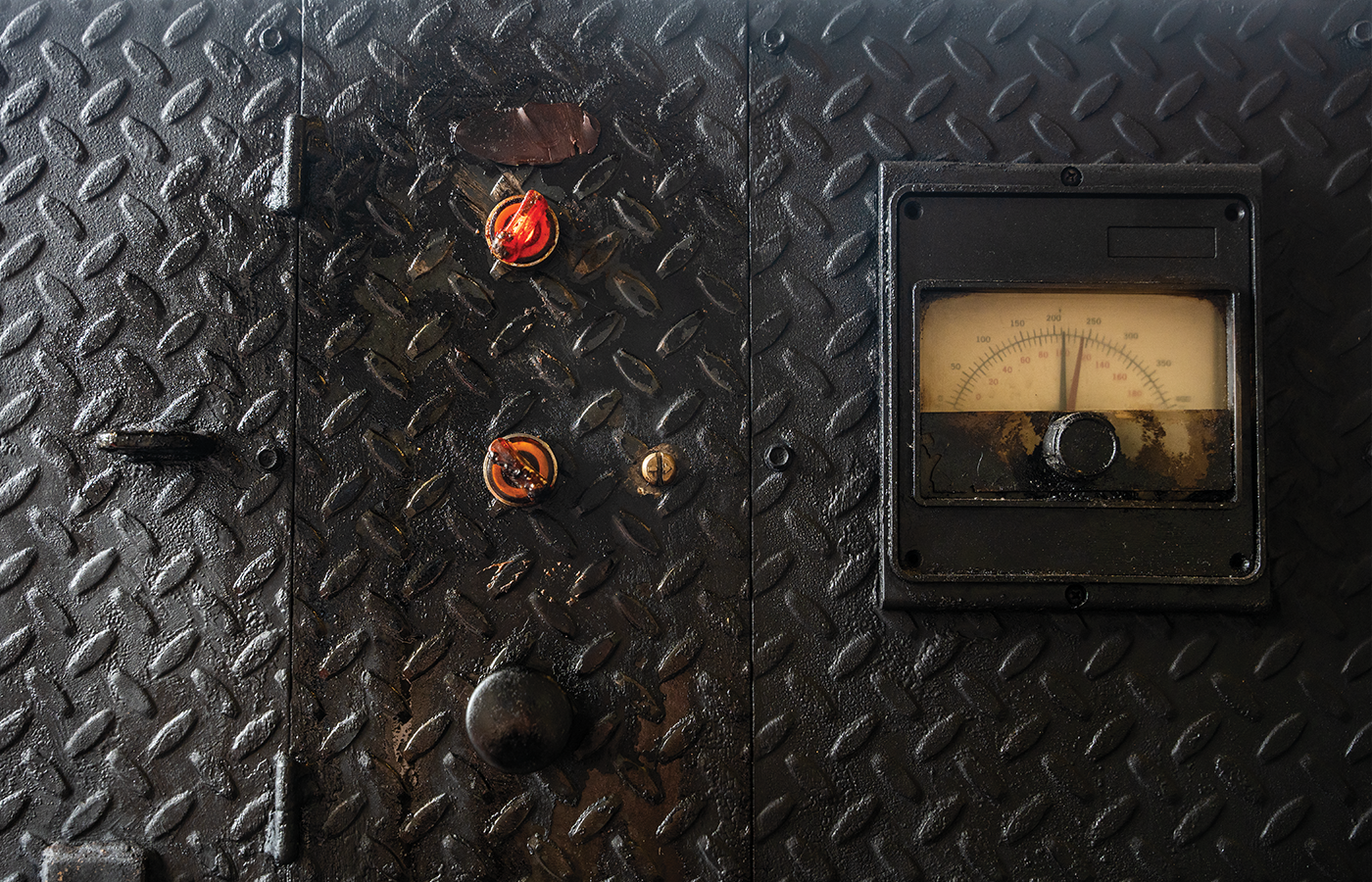
These knobs are used to control pit temperature, which is indicated on the adjacent gauge. (Jud Froelich)
A family on their way to a beach vacation has stopped for dinner at Buz and Ned’s Real Barbecue.
On their way out, they espy a flush-faced Buz sweating at the pit. A little girl asks if that’s “where you make the best ribs of my life?” The dad wants to know about Bobby Flay. At least one high-five is transacted, and a crowd forms on the other side of the steel fence Buz repurposed from a prison.
When Buz’s public is sufficiently charmed and he’s blown their minds with the existence of mutton barbecue in a hinterpart of Kentucky, they smile and move along.
I ask if all this could have happened without Bobby Flay.
“It’s a lot of conjecture, but it helped tremendously,” Buz says. “I was able to put cash away, but I kept it all in the business instead of freaking taking it and putting it in my personal account for my retirement.”
He says, (mostly) joking, that was dumb. Again, the pandemic was hard.
Buz and Ned’s never closed during COVID, but it wasn’t fully open until March 2022. It hobbled forth with takeout and delivery while circumstances demanded Buz’s return to full-time pitmastering.
Around the back of the restaurant is a parking lot abutting a skinny patch of suburban forest. The barbecue pit trailer Buz used to thwart Flay is back there, as are two tractor-trailers stuffed with barbecue business matériel.
Sooner than later, Buz says, he would like to turn this little spot into a dog-friendly picnic area with live music and moody lights. It would make a nice place for a topiary.
For now, it’s where he keeps the raw hickory, much of it still in tree form. Some of the logs are at least 10 feet long and too fat to hug, hence all the chain saws. One time, Buz accidentally chain sawed a portion of his jeans, but nothing else. The incident compelled him to buy armored chaps while giving him a greater appreciation for his femoral artery.
“If somebody’s not working with you long enough to inherit the passion that you have, then they’re just cooking. That’s not what barbecue is.”
“Why,” I say, “are you still out here, lugging wood and meat and lighting fires and doing this every day?”
“I wasn’t doing it for a while, but now, since the pandemic, we’re starting to rebuild the business, and I can’t afford anybody to do what I’m doing right now — until our sales justify it. It’s like starting over 35 years later.”
“I was hoping there’d be some romantic reason. Like you missed doing it.”
“I do miss doing it, but I’m also 70 years old, and it takes a physical toll on you, especially with summer coming up again, and the heat, and being out here. I enjoy the physical part. In fact, I’m a very physical person, and I enjoy the cutting of wood and I enjoy starting the fires. But do I always have the time to do it without compromising something else I should be doing to help run the business and increase sales?”
Buz says his staff is smaller by more than half since the pandemic.
“In an ideal setup, what would you be doing here?” I say. “Just smoking?”
“In an ideal setup? Yeah, I would love to just be on the pits and in the kitchen. I love to cook. I don’t like the stress and angst that running a business gives me.”
“This is hypothetical. Would you ever just go back to having a little joint?”
“I’ve been thinking about that.”
Buz says a fellow Richmond restaurateur not long ago tempted him with a new hole in the wall.
“I wanted to go in there just as a walk-up and do the serve-until-you-run-out kind of concept,” he says. “Everything comes fresh off the pit and goes to the chopping table — the old-fashioned limited menu — but I didn’t have enough staff to be able to do that. The only way I could probably do that now is to shut this place down, but there’s a problem.”
It’s those people who call him “Grossberg.” Buz still has loans, their payments first exacerbated by surprise costs during the two-year Fuddruckers renovation and then (and still) the pandemic. He says the building and land should have been paid off by now.
I think of the flamethrower.
“You could always just burn it down and collect on the insurance.”
“It’s just not a good burn-down situation. It’s brick and there are steel studs and concrete floors. It just doesn’t go very far.”
We’re (mostly) joking.
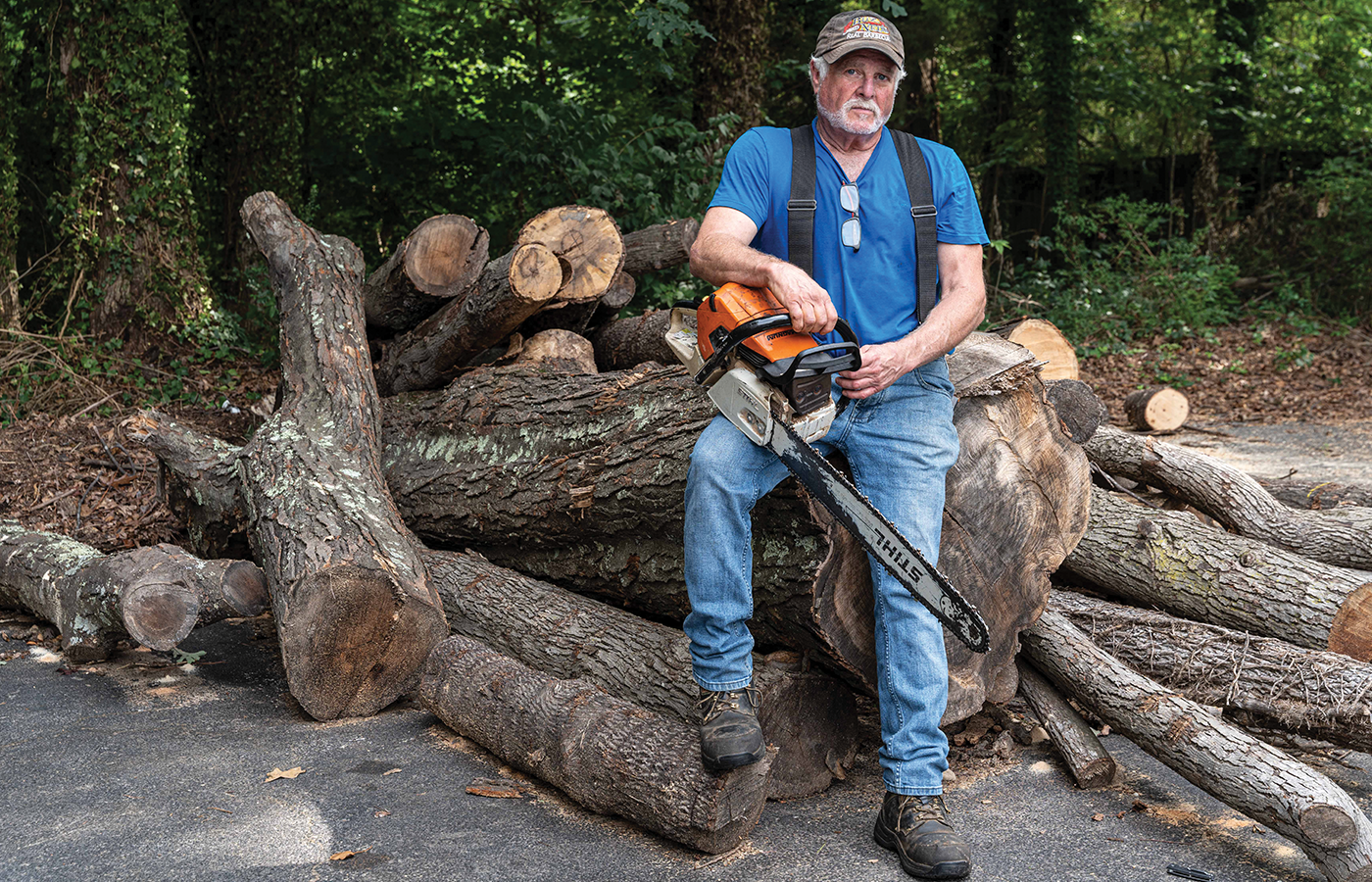
Buz poses with one of his three chain saws on a pile of raw hickory behind the restaurant. (Jud Froelich)
It’s evening now, about 8 p.m., hot, and early twilight pink. Except for the barflies, the restaurant is closed. The briskets and ribs are off the pits, but the butts are taking their time. Buz has a can of Coca-Cola Zero and he’s philosophizing while we wait in the Canadian haze.
“A lot of places have like six sauces,” I say, “but you’ve always had just the one. Why is that?”
“Just because barbecue is regional, it doesn’t mean you have to cater to every region,” Buz says. “Most sauces, they depend on how you cook the barbecue. If you’re cooking North Carolina-style barbecue, where the drippings are doing the flavoring,” — they splash down on coals shoveled directly beneath the meat, creating a gentle smoke — “you really can’t use my sauce. I’ve tried it. It overpowers. On a heavily smoked product like mine, it’s great.”
“Your sauce is like a classic barbecue sauce — I mean that in a good way. Does that make sense?” (J Frank thinks Buz’s sauce could be a cocktail in the bloody mary family.) “It tastes like barbecue sauce. It’s a little sweet, but it’s also balanced.”
“That was my whole idea of cooking, period — not for myself or my own guests, but for the public. You need to like it, but you need to make it for the public — and the public has such varied tastes that you have to be a hybrid of some sort. You have to amalgamate different flavors, different tastes. You don’t want to be too sweet because that can eliminate all the people who can’t stand barbecue sweet. But you don’t want it all vinegar because that’s going to eliminate people who want it sweet. You have to play the game of what the majority of your customers are going to like. You can’t be in extremes.”
“What is your personal taste?”
“I don’t like too much of this or too much of that. I can’t stand too hot food because it takes away from the taste buds. I’m a big balance person — I like balanced food.”
For a moment, Buz digresses back to regional barbecue styles. He practices fidelity to none of them, dubbing his ’cue “Buz style,” even though it seems to gesture vaguely toward Memphis. It’s also changed since his food cart days, when necessity and local barbecue traditions conspired against personal preference.
Today, Buz’s pulled pork sandwich, his bestseller and the signature offering of any pig-forward barbecue shop, comes unsauced to showcase the intimacy between smoke and meat.
Back then, the limitations of a cart made barbecue au naturel impractical.
“If you pull the meat off in the morning,” Buz says, “and you chop it up, put it in a hotel pan, and you’re out of there by 10 o’clock so you can get set up by 11, that barbecue without sauce is going to be dried out and the color is going to change. So I added sauce in there before we left, tossed it up — it was all fresh barbecue tossed up — and it lasted.
“When I opened up at Boulevard, I said, ‘Well, should I do it like I want to do it — no sauce, like traditional classic? Or should I continue to mix the sauce?’ Well, I continued to make some with sauce because that’s what people remembered, and when I got to Broad Street, I said, ‘OK, we’ve got a new building, a new life. Let’s try the no-sauce barbecue,’ and we had some complaints. I probably lost some people.”
“But they can sauce it themselves if they want.”
“It wasn’t the same, actually. When that sauce stays with the meat, it becomes a third product — that’s what traditional Richmond, Virginia, barbecue is: the sauce and the meat together. You get it at the grocery store, put it in your crock pot. Sauce and meat. The old-school stuff like Lexington BBQ — you get the meat, and if you want to put sauce on it, they give you sauce to put on it. It’s all up to you.”
“What do you like?”
“I usually put something like hot sauce on it.”
The pork shoulders are slow-cooked enough. Buz adjusts the sugar-fat-smeared knobs above the first pit’s double doors and relocates a worthy butt to a sheet pan on a rolly cart. He arms himself with a teppanyaki spatula, stabs into the easy-pulling butter muscle opposite the shoulder bone, smears a barky hunk on a potato roll, asks if I like it hot, takes up a 5-ounce bottle of Melinda’s Original Habanero XXXtra Hot Pepper Sauce and shakes out four or five bold douses.
Buz eats a hot sauce barbecue sandwich just off the pit. And so do I.
